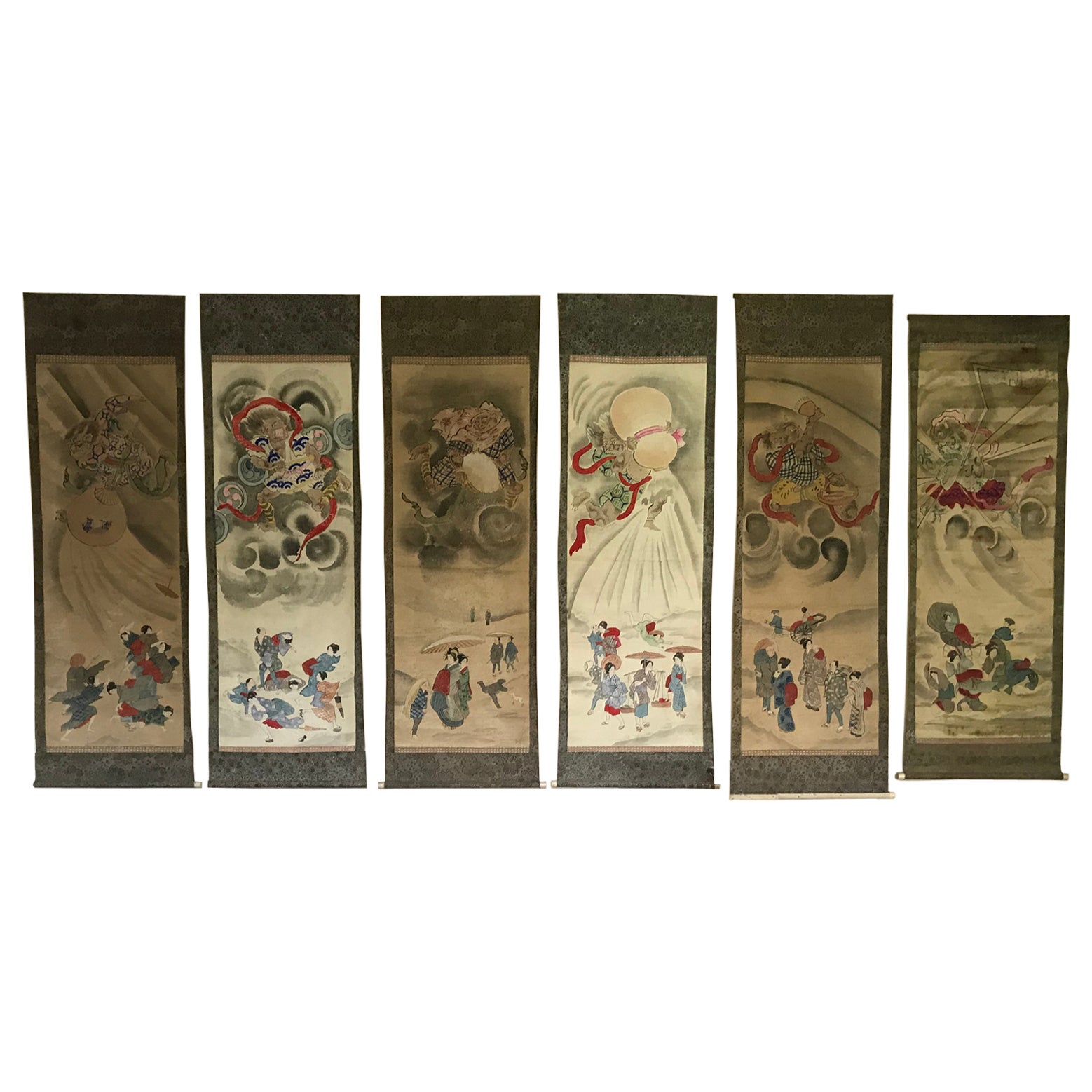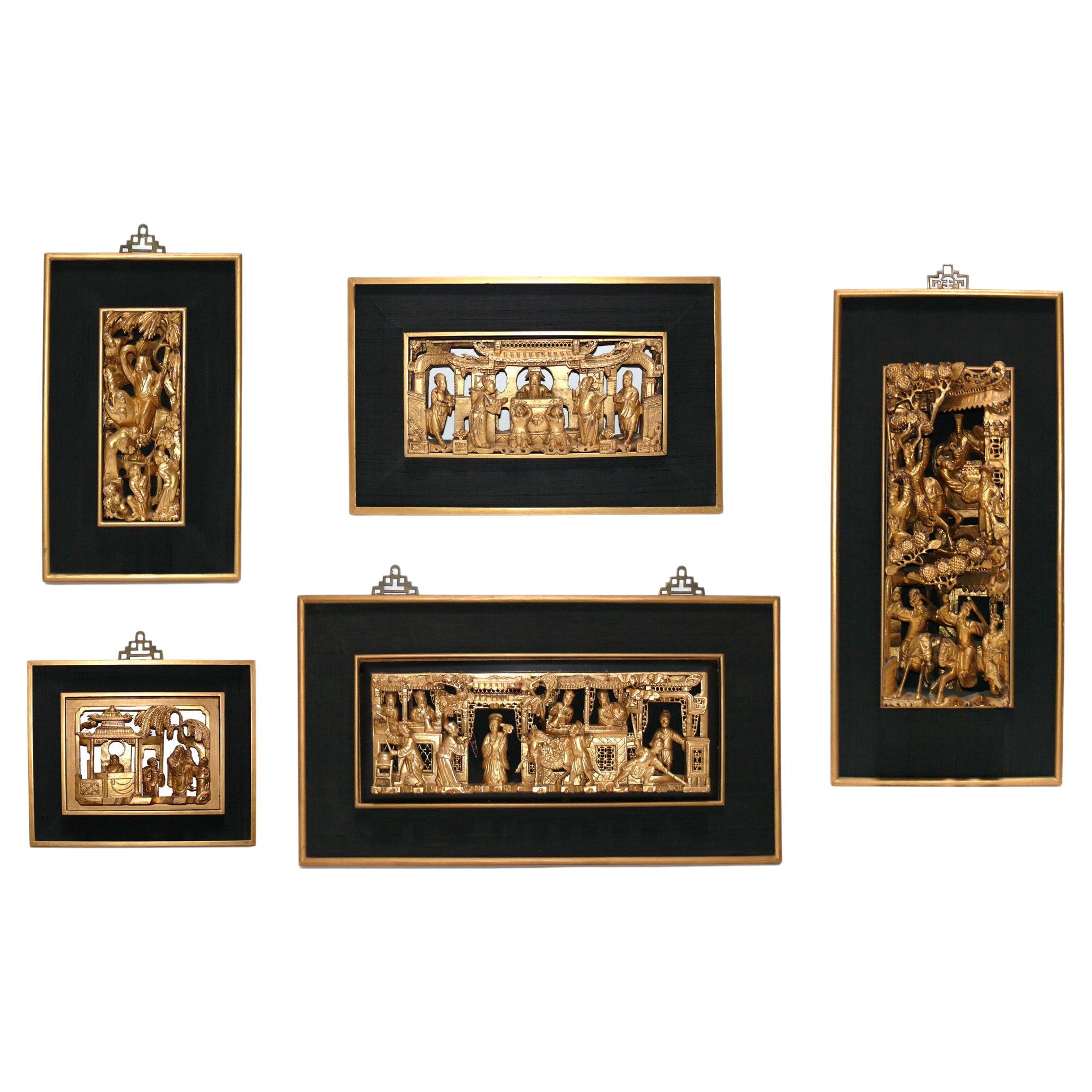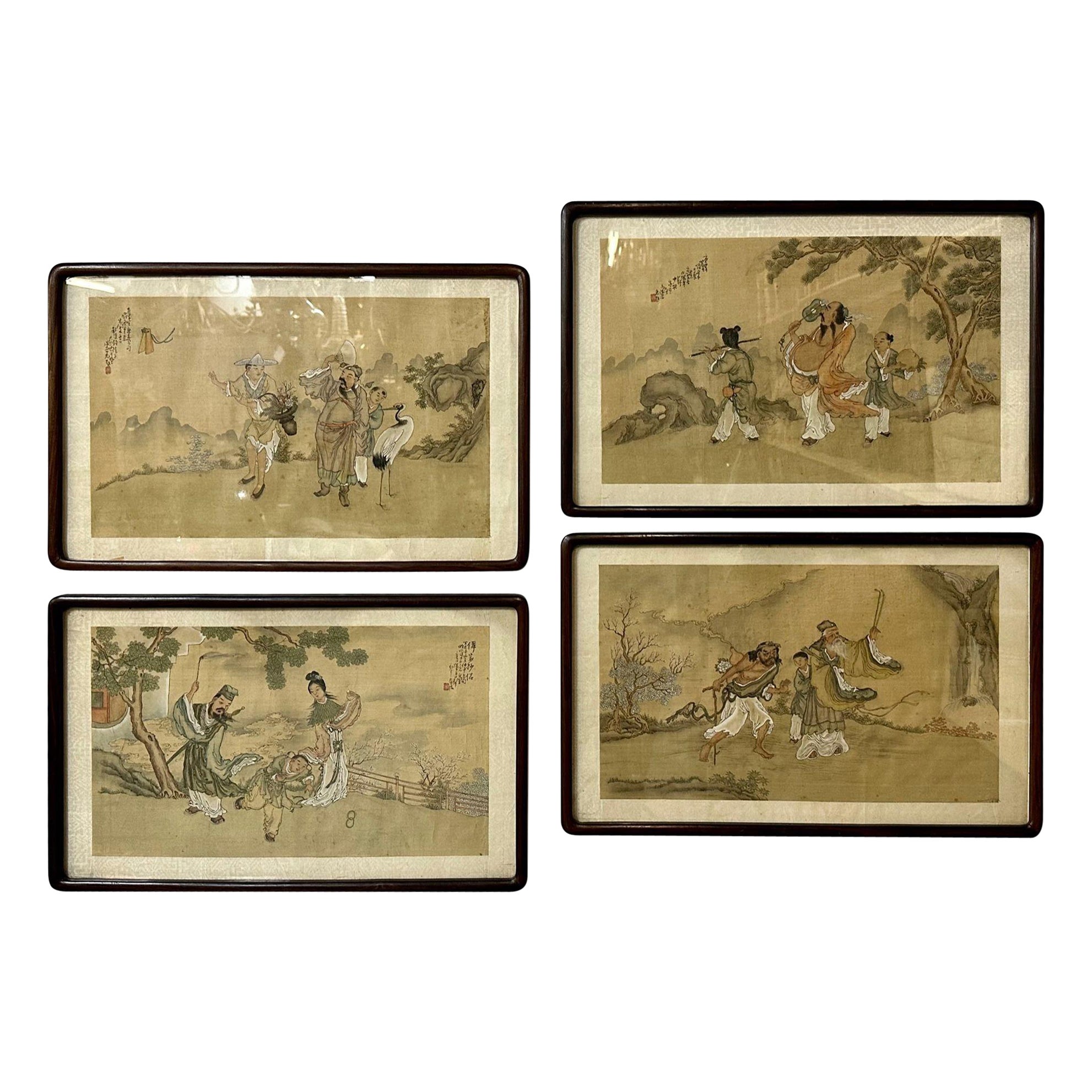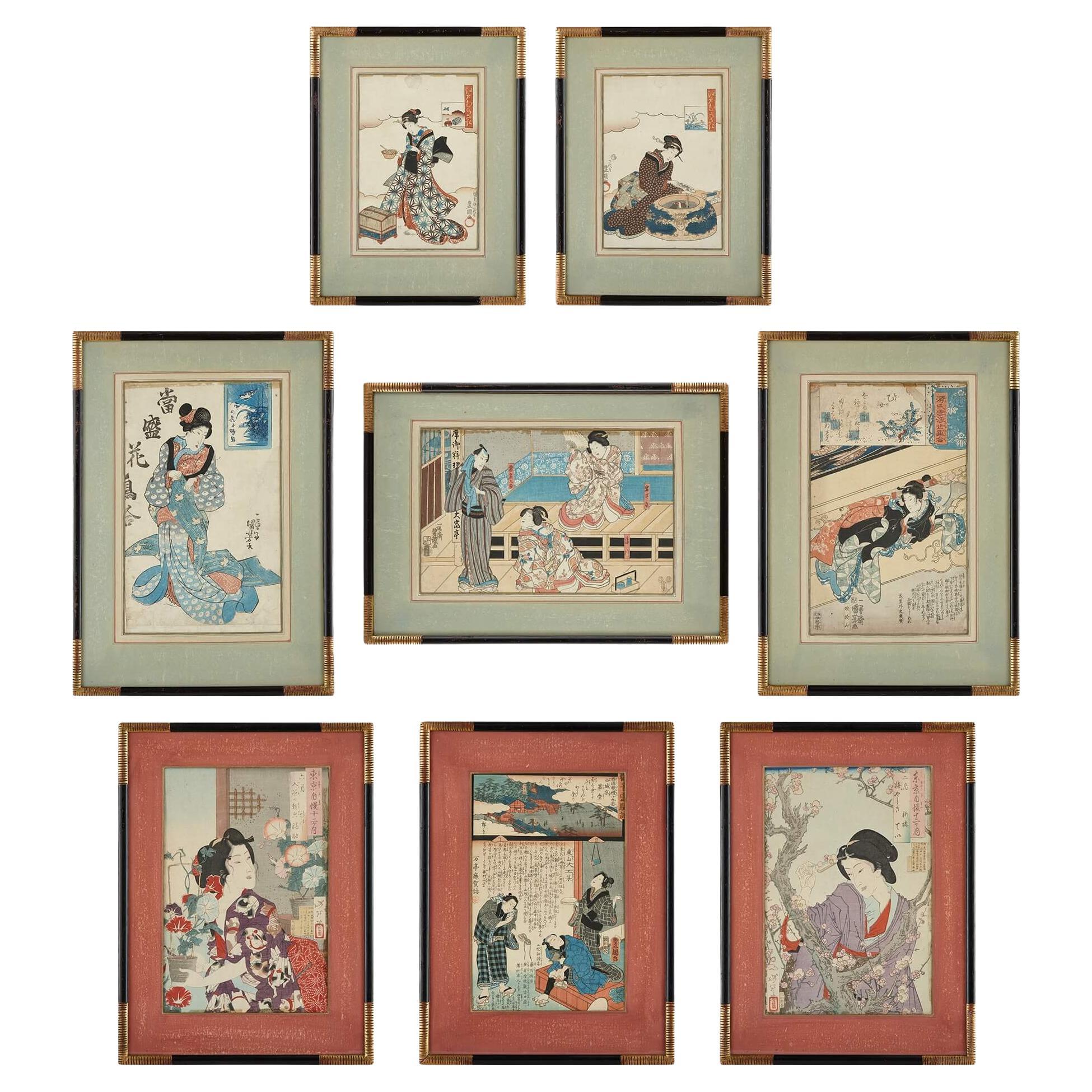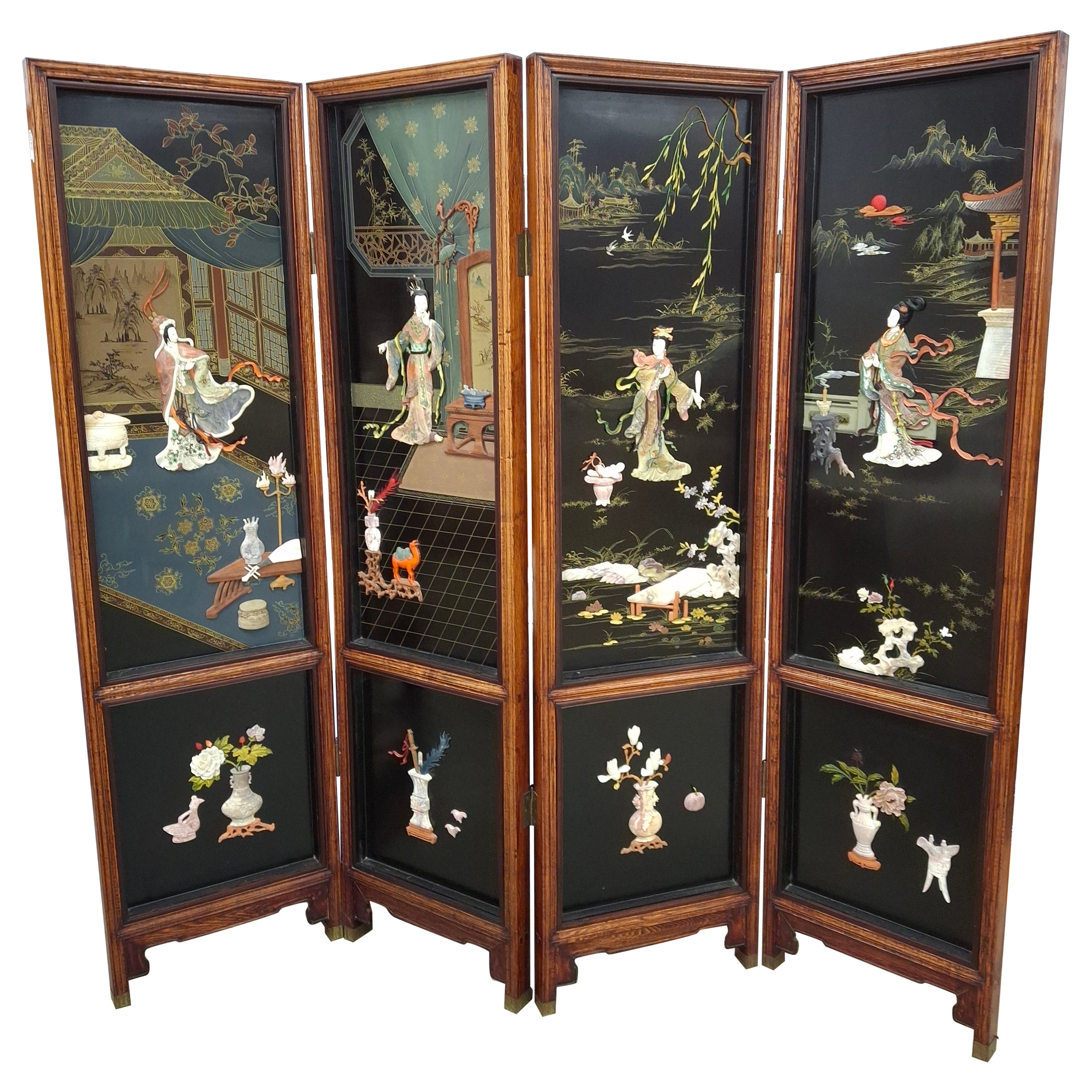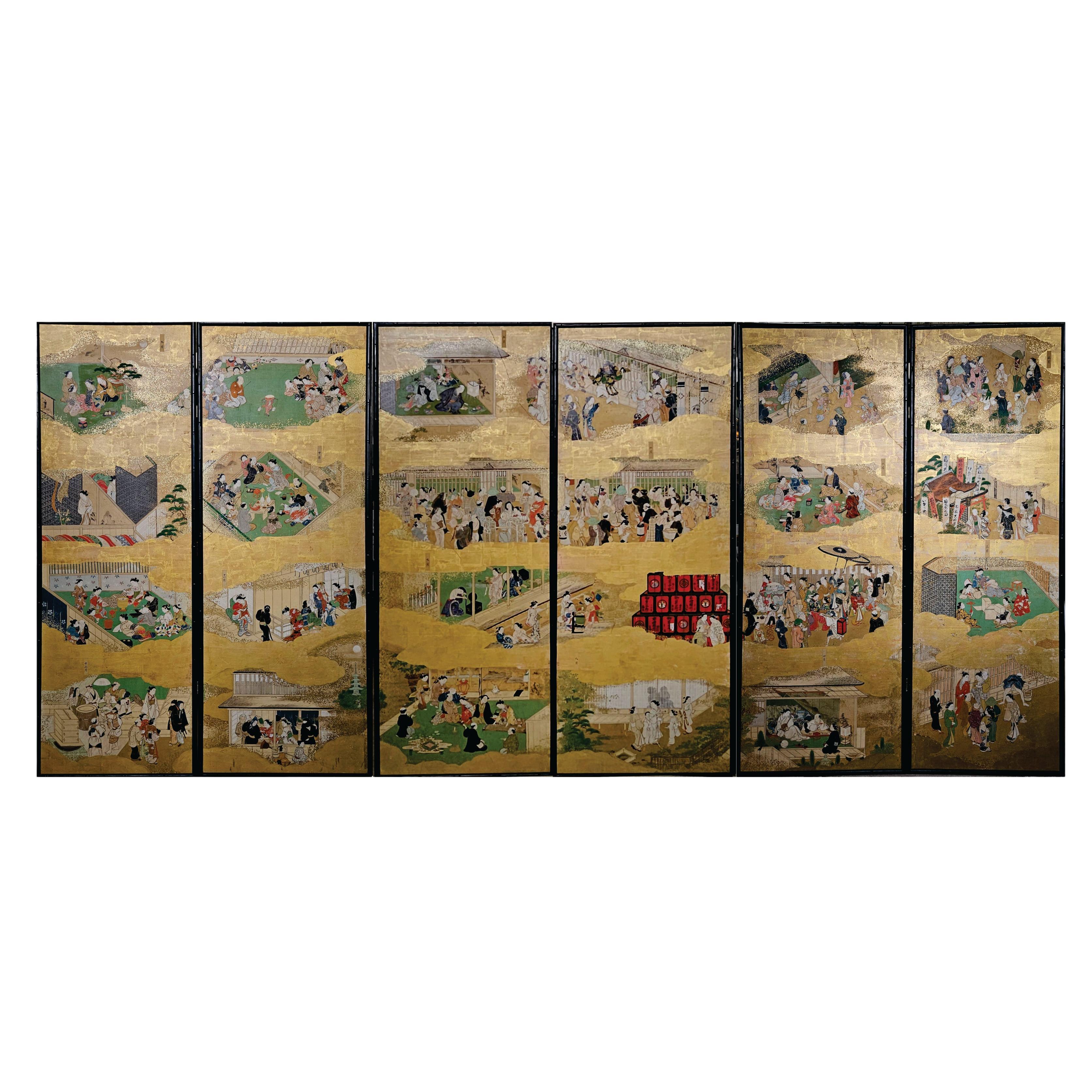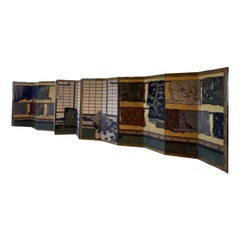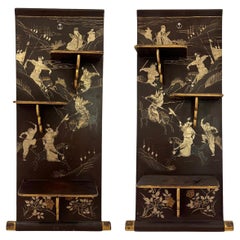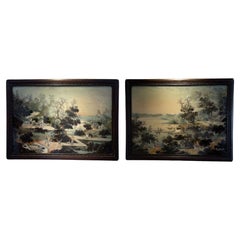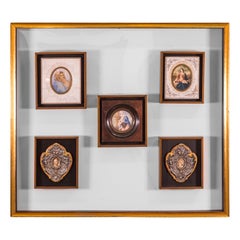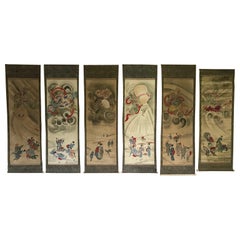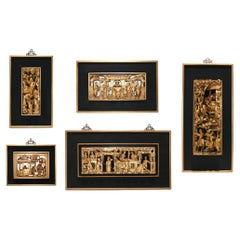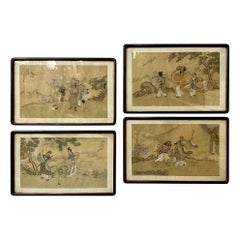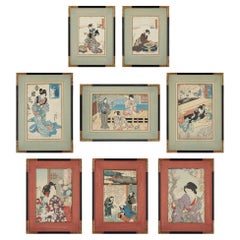Items Similar to Set of Six Japanese Ido Period Shunga 'Erotica' Hanging Lacquered Wood Panels
Want more images or videos?
Request additional images or videos from the seller
1 of 21
Set of Six Japanese Ido Period Shunga 'Erotica' Hanging Lacquered Wood Panels
$69,950per set
£53,076.45per set
€60,688.18per set
CA$97,701.18per set
A$108,630.42per set
CHF 56,720.81per set
MX$1,322,296.75per set
NOK 723,732.86per set
SEK 678,103.11per set
DKK 452,927.02per set
Shipping
Retrieving quote...The 1stDibs Promise:
Authenticity Guarantee,
Money-Back Guarantee,
24-Hour Cancellation
About the Item
These magnificent lacquered wood panels have been mounted together on a lucite panel. Each panel has its original hanging handle. The panels are hanging on antique railroad pins that have been cut and attached to the lucite panel. It has been framed with a double molding, which is made up of a black lacquered wood molding and a walnut burl wood molding. Shunga is a style that was painted by some of the best ukiyo-e artists of the day, including Kitagawa Utamaro and Katsushika Hokusai (Hokusai’s most famous shunga, which features some octopus-on-woman action, was the subject of a 1981 film titled ‘Edo Porn’). Shunga was in demand, and one commission from a wealthy buyer would reportedly keep an ukiyo-e artist eating for months. One, ahem, standout element of shunga is the exaggerated genitalia. This flourish was not, in fact, ukiyo-e artists bragging about the size of their, uh, brushes, but rather an expression of the genitalia as a ‘second face’, one that, unlike the face presented to the public every day, represents one’s true primal desires – hence both the similarity in size and often unnatural physical proximity to the noggin’. Another unique shunga element: both partners are usually fully (well, almost fully) clothed. Unlike in the West, where bare flesh was seen as simultaneously tantalising and taboo, men and women of Edo-era Japan saw each other in the nude regularly at mixed baths and the like. If anything, it was more appealing to see men and women in shunga clothed, as it helped to identify the characters’ walk of life and to emphasise the parts that were exposed (as if they needed any more emphasising). Shunga was widely accepted in the Edo period, owned and displayed by both men and women. Reports from early foreign visitors to Japan describe visits to Japanese homes in which the man and wife of the house proudly show off their shunga collections to their horrified Western guests. The de-shunganisation of Japan came in the Meiji period. Opening itself up to the Western world after centuries of isolation, the Japanese government sought to bring the country in line culturally and morally with the ‘civilised’ West, banning shunga (not to mention fun practices like public nudity and mixed-gender bathing). Police raids in the early 1900s led to the confiscation and destruction of thousands of pieces, and shunga, though no longer banned outright, has remained taboo since. Ironically, it’s again Western influence that’s changing Japanese attitudes towards shunga – this time toward a positive re-evaluation. Many 20th century Western artists have cited the influence of shunga on their work (Picasso liked Hokusai’s aforementioned octopus-starrer so much he painted his own version), helping legitimise the form in the West while it was simultaneously being banned in Japan. More recently, over the past decade there have been major exhibitions of shunga in Helsinki, Milan and Barcelona, culminating in the 2013 exhibition at the British Museum that serves as the basis for Tokyo’s, which ‘The Independent’ praised as being ‘the most explicit and brilliant pictures of pleasure ever produced’.
- Dimensions:Height: 53 in (134.62 cm)Width: 67 in (170.18 cm)Depth: 2 in (5.08 cm)
- Sold As:Set of 9
- Style:Edo (Of the Period)
- Materials and Techniques:
- Place of Origin:
- Period:
- Date of Manufacture:18th Century
- Condition:Wear consistent with age and use. Minor losses. Minor structural damages. Minor fading.
- Seller Location:North Miami, FL
- Reference Number:1stDibs: LU6132226826132
About the Seller
3.7
Vetted Professional Seller
Every seller passes strict standards for authenticity and reliability
Established in 2000
1stDibs seller since 2021
22 sales on 1stDibs
Typical response time: 1 hour
- ShippingRetrieving quote...Shipping from: North Miami, FL
- Return Policy
Authenticity Guarantee
In the unlikely event there’s an issue with an item’s authenticity, contact us within 1 year for a full refund. DetailsMoney-Back Guarantee
If your item is not as described, is damaged in transit, or does not arrive, contact us within 7 days for a full refund. Details24-Hour Cancellation
You have a 24-hour grace period in which to reconsider your purchase, with no questions asked.Vetted Professional Sellers
Our world-class sellers must adhere to strict standards for service and quality, maintaining the integrity of our listings.Price-Match Guarantee
If you find that a seller listed the same item for a lower price elsewhere, we’ll match it.Trusted Global Delivery
Our best-in-class carrier network provides specialized shipping options worldwide, including custom delivery.More From This Seller
View All17th Century 'Late 1600s', Japanese Edo Period 12-Panel Folding Screen Painted
Located in North Miami, FL
A pair of 17th Century (Late 1600s) Japanese Edo screens made of 12-panels. This folding silk screen is painted on a gold leaf background. It has a...
Category
Antique 17th Century Japanese Edo Paintings and Screens
Materials
Silk, Wood, Paint, Paper
19 c Pair Chinese Hand Painted Black Gold and Silver Lacquered Fold Up Wall Shel
Located in North Miami, FL
This beautiful Chinese export black lacquered pair of shelves is decorated with silver and gold leave images of the story of a Chinese warrior battle....
Category
Antique 19th Century Chinese Qing Animal Sculptures
Materials
Gold Leaf, Silver Leaf
Chinese Pair 'Diptych' Reverse Glass Paintings of Port Life, Early 18th Century
Located in North Miami, FL
This pair of reverse glass paintings are truly one-of-a-Kind pieces. The scene has been beautifully rendered, with great attention paid to detail. These piece were created in China d...
Category
Antique 18th Century Chinese Paintings and Screens
Materials
Wood, Glass, Paint
$23,600 Sale Price / set
20% Off
Five European Paintings of the Virgin Mary over White Bone, 18th Century
Located in North Miami, FL
A group of five European paintings of the Virgin Mary over white bone. Each piece is mounted on a hand-painted black panel and framed individually with a gold gilded frame. The grouping is mounted on a Lucite panel, and framed with a coordinating gold gilded frame. Left top: 18th Century Italian painting of Virgin Mary...
Category
Antique 18th Century European Wall-mounted Sculptures
Materials
Gold Leaf
Omnipresence of God, 16th Century, Carved Wood Panel
Located in North Miami, FL
A pair of 16th Century Spanish altar panels of Cherubs Representing the Omnipresence of God mounted on a Lucite panel with a double frame of hand-carved ...
Category
Antique 16th Century Spanish Wall-mounted Sculptures
Materials
Gold Leaf
19th Century Japanese Iron and Mixed Metal Wall Panel
Located in North Miami, FL
A rare Meiji period 1868-1912 iron and mixed metal panel by a highly important early Meiji period artist. The ironwork panel housed within its original hardwood frame depicts the charming subject of a roaster fighting with snake, this particular early Meiji period panel demonstrates all the skills of a leading Mito school metalworker more used to making tsuba and sword fittings for the shogunate and now adapting his unique skills to satisfy the emerging western market, the naive charm and inspiration for this study is probably from an earlier Japanese or even Chinese painting, artists with such breathtaking metalworking skills as this artist could simply replace an artists paintbrush...
Category
Antique 19th Century Japanese Meiji Decorative Art
Materials
Metal, Brass, Bronze, Iron
$39,000 Sale Price
20% Off
You May Also Like
Set of 6 Large Kakemonos Japanese Mythology, 19th Century Japan circa 1800 Edo
Located in Beuzevillette, FR
Beautiful set of 6 large kakemonos from 19th century Japanese mythology.
Paper support with a canvas pasted on the paper
Wonderful set that is part of Japan's history and beliefs
When not hung, the Kakemonos are rolled up.
circa 1800 - Japan - Edo Period
A kakemono translates as "object to hang". In Japan this refers to a painting or calligraphy, most often done on silk or paper framed in a scroll that was intended to be hung on walls or in public lighting. This particular form, which allows them to be in a roll, dates back to the Tang dynasty in China (this would be related to the copying and preservation of ancient Buddhist texts). A Kami is a deity or spirit worshipped in the Shinto religion. A Yokai is a spirit, ghost, demon, or strange apparition from the creatures of Japanese folklore.
Each of these kakemonos represents a unique story:
- A kami, a Japanese deity, is shown painting a rainbow. Indeed, he performs the action with his right hand while his left hand holds a kind of basket with three pots of paint. This kami has a rather closed attitude. He is standing in a dark and tormented sky. Below this figure, 8 villagers are dressed in traditional Japanese clothes. Their faces are softened. They are not afraid of the elements made by the kami above their heads.
- A character with an unreal look is holding a kind of jar with his two hands, which he spills on human figures above. This being is floating in the air, probably a character from mythology, perhaps Susanoo. Underneath, villagers on umbrellas. They are trying to protect themselves as best they can from what is falling on them. One of them is carrying baskets with fish on her shoulders. A character in the background is thrown forward and falls.
- On this kakemono, the god Raijin, dressed in a white and blue outfit, strikes the sky with his two drum hammers to create lightning and its thunderous sound. Surrounded by Tomoe and a long red scarf, Raijin, enraged and with dishevelled hair, creates a dark and violent storm. The villagers seem frightened by this meteorological phenomenon. One of the villagers can be seen fainting in the arms of a man. This scene may seem chaotic, but Japanese legend tells us that once a field is struck by lightning, the harvest is good.
- On this kakemono, we see an unreal-looking figure holding a fan, as if he were sweeping away the bad weather, or simply producing gusts of wind. He is probably the kami of wind and air, Shina tsu-hiko. The figures below him seem surprised by so much wind. An umbrella flies away on the left, the women hold their hair and scarf, the clothes are caught in the power of the wind, there is even a woman on the ground on the bottom left.
- This Kakemono represents a short moment. This Raiju is a yokai (ghost spirit...
Category
Antique 19th Century Japanese Edo Paintings
Materials
Paper
Group of Asian Hand Carved Gilt Wood Plaques
Located in Atlanta, GA
Group of five hand carved gilt wood Asian plaques, probably framed in the 1950s, the carvings may be much earlier. Beautifully framed in gilt frames with ...
Category
Vintage 1950s Chinese Chinoiserie Sculptures and Carvings
Materials
Brass
$1,800 / set
Set of Four Chinese Paintings in Rosewood Frames, Signed, 19th Century
Located in Manhasset, NY
Set of Four Chinese Paintings in Rosewood Frames, Signed, 19th Century, Oil Canvas
Stunning example of Oriental works on canvas on wood. Each in a fine custom rosewood frame, matted. The set depicting a story of a band leader...
Category
Antique Late 18th Century Renaissance Paintings
Materials
Canvas, Paint
Set of Eight Japanese Meiji Era Woodblock Prints
Located in London, GB
A set of eight Japanese Meiji Era woodblock prints.
Japanese, Late 19th century.
Frames: small: height 40cm, width 31cm, depth 1cm - prints: 25 x 17.
Medium: height 49cm, width 37...
Category
Antique Late 19th Century Japanese Meiji Prints
Materials
Paper
$6,165 / set
Japanese Polychrome Oak Lacquer Painted & Carved Stone Figures Four-Panel Screen
Located in Germantown, MD
A stunning Japanese Polychrome Solid Oak Lacquered, Painted and Carved Stone figures Four-Panel Folding Floor Screen.
Measures 79" in width, 2" in depth, 75" in height.
Category
Mid-20th Century Unknown Anglo-Japanese Screens and Room Dividers
Materials
Stone
Japanese 18th Century Tsukinami-e 6 Panel Floor Screen, Edo Period
Located in Norton, MA
A Japanese 18th Century Tsukinami-e 6 Panel Floor Screen depicts the Activities of the Twelve Months of the Year, mineral pigments on gold leaf, mounted on wood panels with 6 frames...
Category
Antique 18th Century Japanese Edo Decorative Boxes
Materials
Gold Leaf
More Ways To Browse
Lacquered Wood Panel
Japanese Wall Hanging
Lucite Framed Art
Antique Japanese Wall Panels
Acrylic Panel Paintings
Antique Japanese Black Lacquer Panels
Japanese Wood Carved Panels
Edo Period Carved Wood
Japanese Burl Wood
Lucite Pins
Carved Octopus
Japanese Erotica
Hokusai Octopus
French Zinc Letters
Micro Mosaic Plaque
Panton Panel
Porsgrund Porselaensfabrik
Verner Panton Mira
